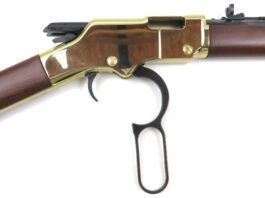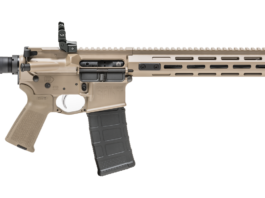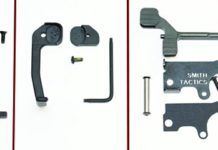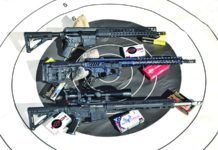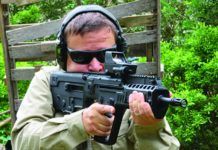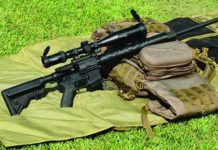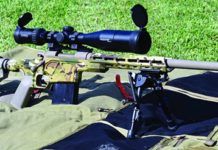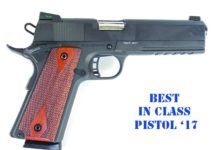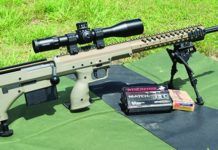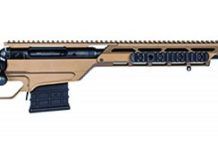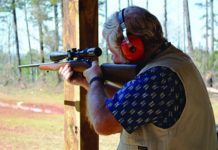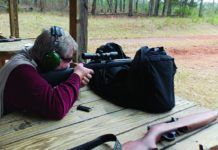Alternate Bolt-Release Levers for the AR-15: We Test Three
When it comes to ambidextrous capabilities, the AR platform still lags behind the modern semi-automatic pistol. How would ambidextrous controls make the AR-15/AR-10 more desirable? One easy answer is to accommodate the left-handed shooter. Another reason would be to help keep the weapon in the fight should the operator be left with only one available hand. Ambidextrous thumb safeties are somewhat popular, and so are magazine releases, but to a lesser extent. The focus of this evaluation is to compare three different aftermarket products that offer a secondary method for releasing the bolt of the AR-15 or AR-10 rifle. They are the $30 Magpul BAD Lever, the $29 Troy Ambidextrous Bolt Release Lever, and the $80 BattleBar from Smith Tactics. Neither the Magpul or the Troy Industries units required disassembly beyond separating the upper and lower ends of the rifle. The BattleBar required replacement of the hammer and trigger pins with supplied components. All three units were made from aluminum.
Protocol for loading the AR-15 begins with pushing the magazine upward into the magazine well until it clicks then tugging on the magazine to make sure it is seated. Next, the bolt release is pressed to bring the gun into battery. Mounted on the left-hand side of the receiver directly above the magazine well, the release is the upper portion of the combination bolt-lock and release lever that pivots with a seesaw motion on a centralized roll pin. Throughout this entire process, the strong hand remains in place, supporting the rifle and maintaining access to the trigger and thumb safety.
By adding any one of our test products, the operator can save some time by moving the hand directly to the support position after seating the magazine. This may seem like a minor consideration, but experienced AR operators point to instances wherein the support hand is needed to push open a door or the shooter needs to fire immediately after completing a reload. Also, participants in High Power Service Rifle competition can use this feature when top-loading single rounds is mandatory. Placing a round into the chamber and closing the bolt with the strong hand is a lot easier than untangling a gloved support hand from a sling. For tests, all three components were mounted on multiple rifles to check fit and function. Let's see how efficiently the three bolt-release levers operated.
AR-10s in 308 Win. and 6.5CM: $995 E.R. Shaw Is a Best Buy
Many people would agree that the AR platform is the most versatile of all rifle designs. Created for military combat (as many sporting rifles were originally), Eugene Stoner's design can be long, short, scoped, topped with iron sights, and maintained by novice operators with just a short list of tools. Also, the design allows for a choice of cartridges, for it is the chambering that defines what it can effectively be used for. In this test, we pitted a gas-impingement-operated 308 Winchester AR-10 against a piston-operated 308 and a gas-impingement AR-10 chambered for what is becoming a popular standard cartridge, the 6.5 Creedmoor.
Our 308 Winchester AR-10s were the $3955 BDR10-3G Black/Blue Splash direct-impingement system and SIG Sauer's $3108 716G2 DMR piston-driven system. A new rifle from the makers of E.R. Shaw Barrels, the E.R. Shaw ERS-10 chambered for 6.5 Creedmoor ammunition was a direct-impingement firearm carrying a list price of $995.
We chose four different rounds for collecting accuracy data from the 100-yard line at American Shooting Centers in Houston. The 308 rifles were fed SIG Sauer's 150-grain HT and 168-grain Open-Tip Match (OTM) ammunition, and two rounds from Black Hills Ammunition. They were the 155-grain Sierra Tipped MatchKing (TMK) rounds and the 175-grain boat-tailed hollowpoints (BTHP). Our 6.5 Creedmoor selections for the E.R. Shaw rifle were Federal's 140-grain soft-point "Non-Typical" White Tail rounds and three varieties from Hornady. They were the 140-grain Extremely Low Drag (ELD) Match, 143-grain ELD-X Precision Hunter, and the 147-grain ELD Match rounds. For optics we relied upon our Steiner 4-16x50mm Steiner Predator Xtreme first focal plane scope mounted inside a pair of 30mm Warne rings atop a riser from Yankee Hill Machine. Let's find out which of our rifle trio was most accurate, reliable, and versatile.
Running the Bullpups: IWI, Kel-Tec, Steyr, and FN Compete
Bullpups were designed for close-quarters battle (CQB) use in cramped environments where a longer weapon can be a liability. They are smaller and more compact than the typical AR-15 rifle. What also differs is how a bullpup functions. These firearms are configured with the action located behind the trigger group. Your nose rests above the action, not behind it like with an AR or AK. That means the magazine is aft of the trigger, not forward. Thus, your reloading technique changes. Because the action is housed in the buttstock, the overall length is reduced, yet a bullpup still deploys the same barrel length as a civilian AR-15. The balance is different with a bullpup, with the weight of the rifle in the butt, not forward of your firing hand. The ejection port is located in the butt, and each bullpup we tested had a different philosophy on how and where empty cases should be dumped. The muzzle is likewise closer, so reaching out with your support arm and pulling the rifle into your shoulder — like with an AR — is not possible, but the bullpups offer other support-grip options.
Basically, then, everything from reloading to grip and handling changes when running a bullpup, so we wanted to see which bullpup we could adapt to more easily. Our quartet of bullpups included three chambered in 5.56mm, which was the IWI Tavor X95 XB16, the Steyr AUG A3 M1, and Kel-Tec's RDB. The fourth bullpup was the FN Model PS90 Standard chambered in 5.7x28mm. This is a nice sampling of bullpups because the AUG could be considered the Rolex of bullpups, while the Kel-Tec is the Timex at a much lower price. All performed without malfunctions, so they all took a licking and kept on ticking. One, the IWI, was modular and offered easy caliber conversion. All were optics-ready except the AUG (pronounced "A-U-G" not "awg"), which came from the factory with an optic. One, the FN, we had to study to even determine how to pick it up and shoulder it, but when we did we experienced a clear engineering solution to bad bullpup ergonomics. With the Kel-Tec, we ended up calling it the working man's bullpup. Nothing fancy, but it kept pace with the other three. In hand, the bullpups feel like an AR-15 short-barreled rifle, or SBR, which require special tax stamps to own.
We tested all except the AUG with either a SIG Romeo4B or a Mepro Tru-Dot RDS. Both are red-dot sights that excel at close-to-medium range. At ranges out to 100 yards, the dot suffices for most targets, but a crosshair reticle would shrink groups. The Romeo4B allows the user to toggle between four different reticles: 2-minute-of-angle dot, 2-MOA dot with ballistic holds, 2-MOA/65 MOA Circle Dot, or 2-MOA/65 MOA Circle Dot with ballistic holds. The ballistic holdover points are calibrated for 5.56 NATO and 7.62x51mm NATO rounds. A feature we liked was the activated motion sensor that immediately powers up illumination when the red dot senses motion and powers down when it does not to extend battery life. The Mepro Tru-Dot RDS we like and have used it for a number tests on AR-style firearms. It features a 1.8-MOA dot reticle and is constructed with an aluminum body and tough polymer frame around a large viewing window. This sight is easy to use when shooting with both eyes open. It runs on one AA battery, and you don't need any tools to change the battery or adjust the sight. It also turns off when not in use to conserve battery life. Both are good choices for AR applications, and as we found out, these bullpups, like ARs, have a straight comb and optics needed to be mounted high. Be aware that a bullpup is capable of hitting targets at the same ranges as an AR-15 with an appropriate optic.
Two of the bullpups — the IWI and Kel-Tec — are compatible with standard AR-15 magazines, which we appreciated since we have plenty of AR-15 magazines on hand. We used Brownells' aluminum-body magazines (Brownells.com, $14) Magpul Pmags (Brownells.com, $12.30), and Hexmag tubes (Brownells.com, $12); all were 30-rounders. The AUG and FN used proprietary magazines. Like an AR-15, the FN, IWI, AUG, and Kel-Tec allow the operator to keep his firing hand on the grip while performing a reload with the support hand.
The three brands of AR-suitable ammunition we tested included Aguila 5.56mm NATO with a 62-grain FMJ bullet, 223 Remington Federal Fusion loaded with a 62-grain soft point, and SIG Sauer's 223 Remington ammo loaded with a 77-grain Open-Tip Match (OTM) bullet. For the FN, we used FN 5.7x28mm 40-grain V-Max and Federal American Eagle 40-grain FMJs. We noticed big differences in recoil and muzzle blast between the 5.56 NATO and 5.7x28mm ammo. The 5.7x28mm ammo was similar to shooting 22 Magnum ammo — minimal recoil and not as much muzzle blast as the 5.56mm NATO.
Bigger ARs: 6.5 Creedmoor, 6.5 Grendel, & 308 Winchester
The history of popular firearms in the 21st Century (so far) has been indelibly marked by the rise of civilian-owned AR-15 semi-automatic rifles. What most people don't know is that the system was originally intended to fire larger-caliber ammunition than 5.56mm or 223 Remington. Designed by Eugene Stoner, the AR-10 (the "AR" is short for "ArmaLite Rifle," not "assault rifle" as many non-gunners believe) evolved from the 7.62x51mm NATO chambering to smaller calibers for greater reliability and practicality; in particular, soldiers were able to carry more ammunition because the bullets and magazines were smaller and weighed less. The structure of the rifle itself could be made lighter as well without the fear of receivers cracking or pins working loose. In this last regard, such was the state of metallurgy and machining in the 1960s.
In today's manufacturing world, advanced technology provides for more exacting tolerances so that finished products are more consistent. And thanks to the space program and other factors, stainless steel and other metals are more malleable and durable than ever. With the Pentagon still chasing a more effective round than 5.56/223 and the public's thirst for a bigger bang, a return to larger calibers for the AR platform was inevitable. In this test we compare three different ways to project larger-diameter bullets. Our first test rifle (or carbine, if you will) was the $3999 MR762A1 from Heckler & Koch. As its nomenclature suggests, the MR762 fires 7.62x51mm ammunition or its American incarnation, 308 Winchester. From Core15 rifles in Ocala, Florida, we chose the $2470 Core30 Tac II chambered in 6.5 Creedmoor, which fired 0.264-inch-diameter bullets. Our third rifle also shot 0.264-inch bullets, but from a cartridge case short enough to be housed in the smaller AR-15 chassis. Alexander Arms managed to stuff Bill Alexander's invention, the 6.5 Grendel, into an AR-15 receiver and topped it off with a 24-inch-long barrel. List price of the Alexander Arms Overwatch rifle we tested was $1613.
For 6.5 Grendel shots of record, we chose 120-grain American Eagle, 123-grain Hornady A-Max, and Alexander Arms' own brand of ammunition topped with the 123-grain Lapua Scenar bullet. Our H&K MR762A1 was treated to 110-grain FB-tipped rounds from Noveske, 168-grain OTM rounds, and 150-grain HT rounds from SIG Sauer, plus a diet of Black Hills Gold 155-grain Tipped Match King ammunition. The Core30 rifle was loaded with all Hornady brand ammunition; the 129-grain White Tail Interlock, 140-grain ELD Match, 143-grain Precision Hunter ELD-X, and 147-grain ELD-Match rounds.
For optics we used both a 4-16x50mm Steiner Predator Xtreme scope and SIG Sauer's new Tango6 4-24x50mm scope. The Tango6 is a compact scope for its maximum power of 24x magnification. In our view, this makes it a good choice for semi-automatic rifles that already have a lot of mass top to bottom thanks to the pistol grip, and you don't want the rings or mount to put weight on the handguard. Both the Steiner and the SIG were first-focal-plane scopes so we could manipulate the size of the reticle. We especially liked using the small dot in the center of the Tango6 reticle. Not really visible until reaching 8x magnification, we were able to enlarge the dot to just the right diameter to indicate dead center but not significantly block the target.
Tests were performed at American Shooting Centers in Houston, Texas. Accuracy data was collected from the 100-yard benches. We also made use of the 400-yard range where a variety of steel targets stood to challenge those who dare. We fired at the 18-inch-wide by 30-inch-tall IPSC/USPSA target to test our skills. With three rifles that were different in concept and caliber, we wondered if one would stand above the others in all aspects of performance. Or would each rifle claim supremacy when viewed in a specific role. Let's find out.
We Wouldn’t Buy Ruger or Howa Precision Rifles
When a firearm leaves the factory in a condition that precludes the buyer from using it as designed, that firearm deserves an "F." I believe it is acceptable to point out whether the problem is severe or an easy fix. However, the evaluation needs to stress that the firearm should have never left the factory in the condition tested. Personally, regardless of the grades given, I would not buy the Ruger or the Howa. Keep up the good work.
2017 Guns & Gear Top Picks
Toward the end of each year, I survey the work R.K. Campbell, Roger Eckstine, Austin Miller, Robert Sadowski, David Tannahill, Tracey Taylor, John Taylor, and Ralph Winingham have done in Gun Tests, with an eye toward selecting guns, accessories, and ammunition the magazine's testers have endorsed. From these evaluations I pick the best from a full year's worth of tests and distill recommendations for readers, who often use them as shopping guides. These choices are a mixture of our original tests and other information I've compiled during the year. After we roll high-rated test products into long-term testing, I keep tabs on how those guns do, and if the firearms and accessories continue performing well, then I have confidence including them in this wrap-up.
Options in Precision Rifle: We Test Desert Tech, Howa, Ruger
Trends in firearms sales reflect the needs and interests of the buying public. Whereas the AR-15 or "black rifle" market has slowed down considerably, the popularity of rifles that are capable of accuracy beyond the 300-, 600-, or even 1000-yard range is still going strong. Referred to as precision rifles, the traditional configuration of a barreled action bedded into a wood or fiberglass stock are being challenged by aluminum and synthetic chassis rifles. What's more, the 6.5 Creedmoor cartridge is rapidly becoming a favorite round. In this test, we decided to review three different types of rifles chambered to propel 0.264-inch diameter bullets that represent options to satisfy the long-distance enthusiast.
In this test, the traditional bolt-action rifle was represented by a new offering from Ruger that has, to the best of our knowledge, received virtually no press. Our $1139 6.5 Creedmoor Hawkeye MkIV Varmint Target boasted a 28-inch-long barrel, the longest tube we've heard of in quite some time. Howa's $1450 HCR (Howa Chassis Rifle) was next up, featuring a fully adjustable buttstock from LUTH AR. Finally, we tried a unique design by Desert Tech. The $4995 Stealth Recon Scout (SRS-A1) lives up to its name by offering a 26-inch-long barrel packed into a compact profile.
For optics, our rifles shared a Steiner 4-16x50mm Predator Extreme scope. We also took turns looking down range with a Kahles 3-12x50mm scope supplied by Desert Tech. We painstakingly took time to break in the barrel of each rifle and then fired from the 100-yard line at American Shooting Center in Houston to collect basic accuracy data. For shots of record, we chose Winchester 140-grain Match, Hornady 143-grain ELD-X Precision Hunter, and the new 147-grain ELD Match rounds. We also shot a variety of rounds left over from previous tests to perform break in and for general comparison. What were the strengths and limitations of these three different platforms? Let's find out.
Savage Introduces the 10/110 Stealth Evolution in Six Calibers
Savage has introduced the 10/110 Stealth Evolution chassis rifle chambered in six popular long-range calibers, including the all-new 6mm Creedmoor. The rifle is available in both right-hand and left-hand models. Shipments are currently being delivered to dealers.
The 10/110 Stealth Evolution pairs a heavy fluted barrel with a monolithic aluminum chassis finished in rugged bronze Cerakote. The polymer-ceramic coating enhances resistance to abrasion, corrosion, and impact. The rifle also sports a factory-blueprinted 10/110 action, zero-tolerance headspacing, user-adjustable AccuTrigger and 5R button rifling. The company claims the rifle will produce sub-MOA accuracy at extreme range right out of the box.
All-Round 308 Winchester Rifle Shoot-Out: Not Our Faves
Looking for a go-anywhere do-anything 308 Winchester-chambered rifle? If so, in this article we test Remington SPS bolt guns in two variants, a Tactical version with a carbine-length barrel at 16.5 inches and the 26-inch barrel SPS Varmint, to get a good look at opposite ends of the length spectrum. Then we added two rifles with more traditional barrel lengths, the 22-inch-barrel Savage Axis and a semi-auto, the Browning Automatic Rifle Stalker, also with a 22-inch tube.
The truth is, these rifles will fire most of their cartridges on a range. This means we'd like them to be comfortable to shoot and deliver satisfying accuracy. Hunting is a consideration, of course, so the rifle should be useful for thin-skinned game to 200 yards or more. The adage of "200-pound game at 200 yards" will apply here. In a dangerous world in which it may be the only self-defense option for some homes, the rifle should also have some utility as an emergency rifle or for area defense. It should handle quickly enough for boar hunting, or varmints and pests, such as coyotes if need be. Area defense simply means that those of us with a larger homestead or a potential campsite do not wish to be helpless if we encounter adversaries. And we'd prefer our choice not cost as much as a Scout.
Obviously, then, we want a dependable, easy-to-shoot, easy-to-carry rifle that's well made. Doesn't sound that hard because we are not expecting to be able to light a match with each round, but we do want to hit the K zone at 200 yards. Some shooters have claimed that shorter, stiffer barrels like that on the Tactical shoot as well as a longer barrel, like that on the Varmint. We are going to see how velocity varies as well, and to compare the chronograph stats bolt guns develop in terms of velocity to that of a semi-auto. We do not want a 4-foot-long 12-pound rifle, but we wondered if we would have to compromise on weight (that is, go heavier) if we do not get the accuracy we want. We are not holding out for accuracy for 50 continuous shots and do not need a heavy target barrel, but, instead, we're looking for a rifle capable of delivering good accuracy for a dozen shots or so. Durability and quality are important. The rifle should last for the shooter's entire life. Also, to save money, we looked for used rifles in Like New or better shape, a standard which all four members of the quartet met.
We elected to fire the rifles in four drills. We would fire quickly at human-silhouette targets at 25 yards, for the SHTF situation. It is also a drill that has some merit in learning to snap-shoot predators and coyote. At 50 yards, we used the Innovative Targets (Innovative Targets.net) steel gong. While we fired for precision, we also wished to test speed to an extent in this drill and fired a combination of standing and kneeling. We would expend 20 rounds in each pursuit, at 25 and 50 yards, for 40 rounds. We also fired 10 rounds at 100 yards offhand. Finally, we fired three three-shot groups for accuracy at 100 yards with three different loads, alternating between rifles to let the barrels cool, firing from a solid rest and attempting to obtain the best accuracy possible. During the offhand firing stages, we used Fiocchi 150-grain FMJs for the 25- and 50-yard work. For firing offhand at 100 yards, we used a handload consisting of the Hornady 155-grain SST and Varget powder for 2750 fps. For benchrest accuracy testing, we used three loads. The Hornady 168-grain ELD Match, Federal 165-grain Trophy Bonded, and Gorilla Ammunition's 175-grain Sierra MatchKing load. Here's how they performed.
All the cartridges tested gave good-enough results as far as baseline expectations, we thought. That is, we had no failures to feed, fire, or eject in the test. And all three produced a level of accuracy we want to see—1 minute of angle, or 1-inch groups at 100 yards—in at least one rifle. For example, the Gorilla Ammunition 175-grain rounds gave the best results in the Remington SPS Varmint at an eye-popping 0.9-inch average group size, then the SPS Tactical at 1.2 inches, the BAR Stalker semi-auto at 1.6 inches, and the Savage at 1.9 inches on average, far behind the leader. We saw the same pattern with the Hornady ELD Match 168-grain Polymer Tip load, with the Varmint again shooting under MOA with a 0.9-inch average group, the Tactical at 1.4 inches, the MK3 BAR at 1.5 inches, and the Axis coming in at 2.3 inches. Likewise, the SPS Varmint lead the parade with the Federal Trophy Bonded 165-grain Polymer Tip load, shooting 1.0-inch average groups. The BAR jumped into second place with this load, shooting slightly better at 1.7 inches than the Tactical's 1.9-inch average. The Axis was fourth again with an average group size of 2.2 inches.
Ruger Recalls Most Mark IVs
Ruger has issued a wide recall of all Mark IV and 22/45 models because of a problem with the safety and sear and has told owners that the pistols should not be used.
The issue is: In some cases, if the trigger is pulled while the safety lever is midway between the "safe" and "fire" positions and not full engaged in either, the pistol may or may not fire when the trigger is pulled.
If the gun doesn't fire when the trigger is pulled, it may fire if the user then pushes the safety to the "fire" position without the trigger being activated.
Here's a statement from a Ruger press release on the company's website:
"Although only a small percentage of pistols appear to be affected and we are not aware of any injuries, Ruger is firmly committed to safety and would like to retrofit all potentially affected pistols with an updated safety mechanism. Until your Mark IV pistol has been retrofitted or you verify that it is not subject to the recall, we strongly recommend that you not use your pistol."
Ruger says they have received a "small number" of reports from the field indicating the problem exists. Additional testing confirmed the issue and the recall was issued.
22 LR Bolt-Action Rifles: We Test CZ, Savage, and Marlin
The 22-caliber rimfire bolt-action rifle owns a warm sport in the heart of many shooters because they were often the first rifle that many of us fired. Many pleasant hours are spent with such a rifle. The experience unites shooters across a spectrum of lifestyles. But in the present, the bolt rimfire can also be an economical, accurate, and reliable firearm for plinking, small-game hunting, and informal target practice. The bolt action rifle has a reputation for superior accuracy over the self-loader, and, overall, our testing proves this out. In this report, we test a quartet of entry-level and higher-end rifles to see what it takes to get our money's worth, however that is defined. Our test guns this round included the Savage Mark II F 26700, $231; the CZ-USA CZ 455 American 02110, $400; the Marlin XT 22RZ 70763, $220; and the Savage Mark II BTV 28750, $390.
Accuracy testing was conducted with three loads. Winchester's M22 loading came from SportsmansGuide.com ($75/1000); MidwayUSA.com supplied the CCI Velocitor ($7.40/50); and Fiocchi's HV rounds ($6.50/50) originated from Bulkammo.com. We also conducted side tests with low-velocity subsonic loads, including the CCI Segmented load. For offhand shooting, we used Winchester M22 rounds to gauge the rifles' smoothness and handling in firing at targets at known and unknown ranges.
There were no defects that made any rifle less desirable, when the price points were considered. The two inexpensive rifles gave a credible performance. For small-game hunting at treetop height and out to 25 yards, there would be little reason to spend a lot. In fact, you'd have to go out to 50 yards to see the Savage BTV was the most accurate rifle.
Rimfire Field-Rifle Shoot-out: Marlin, Mossberg, and Ruger
In this installment, we test three rimfire rifles from three makers. The genre is the very popular and flexible field-gun description. The 22 LR rifle is an excellent trainer, a favorite recreational shooter, and a great small-game rifle. The rimfire is the one rifle every rifleman must have. The field gun is by definition, and the definition is liberal, a versatile go-anywhere get-anything shooter. Informal practice and small-game shooting are great pastimes. And while we are not focusing on personal defense, we should note that a good quality 22-caliber self-loader is a formidable firearm in skilled hands. Is a 22 LR a self-defense chambering we'd recommend? No. Have untold numbers of bad guys been deterred by being hit with a 22 LR round fired from a pistol or rifle? Yes. So reliability is important as well.
The rifle we are looking for should be light but not too light. It should be light enough for carrying for a day in the field, but it should have sufficient heft for good offhand shooting. While we carefully measure accuracy by firing from a solid bench rest, we also want a rifle that retains a good portion of its accuracy in offhand fire. Thus, a good balance of weight and a decent trigger action are desirable traits.
Historically, probably more 22 LR rifles have been set up as bolt actions, but because of their light recoil and shot-to-shot speed, self-loading rifles are the biggest sellers today. To keep prices in check, we selected a mix of readily available used and new firearms as well as optics for greater coverage of the best choices. As noted above, reliability is always important, but in this test, we allowed that if the firearm occasionally ties up and we lose a squirrel, we were more willing to give a gun a pass than if we were testing personal-defense firearms. It is almost a given that a 22 self-loading rifle malfunctions from time to time, and the fault is more often due to the construction of the 22 rimfire cartridge than any other single variable. We searched for ideal rifles and found some good picks. All had good points. Here's how they performed on a gun-by-gun basis.





























